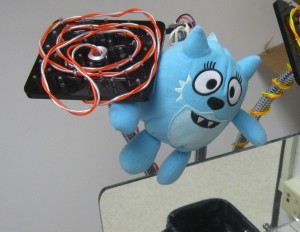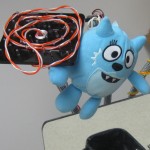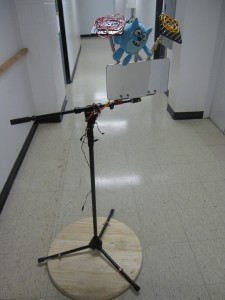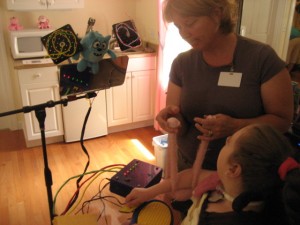Designers: Ariella Nouriel and Kuai Yu
Client Coordinator: Cindy Wyatt, OT
[youtube]http://www.youtube.com/watch?v=PwCH7kz7RGM[/youtube]
INTRODUCTION
Our client is a 9-year-old girl with spastic quadriplegia cerebral palsy and cortical visual impairment. While she has severe cognitive impairment, she has normal hearing and demonstrates a positive response to simultaneous audio and visual signals. She wears a brace for trunk support, and manages switch controls with her hands, though their movements still remain highly limited. Due to her visual impairment, she is unable to see peripherally and her right eye is dominant. She also does not detect all colors and therefore prefers brighter shades such as red and yellow against a dark background. She enjoys playing computer games using special software.
See Me Move is intended for home use while in a wheelchair, stander, or in bed. When the client presses a switch, the device responds with musical and/or visual feedback, as well as a shaking toy. The caregiver, parent, or therapist can select the desired feedback. The goal is to improve our client’s ability to use her vision together with hearing as stimuli. The second goal is to encourage more targeted and controlled hand movements.

Figure 1b: A close up of the mirror (bottom right), electroluminescent wires (top left), and shaking toy (center).
SUMMARY OF IMPACT
The client actively pushed her switch while in her stander and vocalized positive feedback. Furthermore, the device allowed for the client’s first active participation in play from her bed. One of her nurses noted that “[this device is] pretty good for her because she’s been up [in her stander] for almost an hour and a half … and she’s still interested in it … and that’s unusual.” The nurse also indicated that the client will likely use the device often and it will increase her ability to rely on her vision and hearing as a stimulus, as well as create more targeted and controlled hand movements.
TECHNICAL DESCRIPTION
The device is mounted to the end of a microphone boom stand. A wooden base is attached and secured to the bottom of the stand to increase stabilization. The height of the stand is easily adjustable, and therefore the device can be used at locations of varying heights including the client’s wheelchair, stander, and bed. The commercial switch is mounted to one of the client’s existing trays. We made a C-shaped acrylic switch holder so that the switch can be placed face-up for normal push down activation, or upside-down for push-up activation. The device includes an acrylic mirror so that the client can see her own hands while pressing a switch, which she finds interesting because her limited field of view often makes this impossible. The mirror is mounted with a friction hinge so that it can be rotated to the proper position, or out of the way if desired.
A custom milled aluminum plate and bracket is attached at the end of the microphone boom. Three microphone goosenecks are attached to this plate to hold the three rewards: a lightshow with two different colored electroluminescent wires, a shaking toy, and a second lightshow with two more different colored wires. The use of the goosenecks allows for the custom positioning of the rewards to the client’s current field of view as well as the ability of running wires through their hollow middles.
The electroluminescent (EL) wires used for the light show rest on acrylic plates that contain numerous pegs which allow the user to create any desired shape with the wire. The pegs are made of clear acrylic rods. The EL wires can be configured to light in sync with the music that the device is currently playing. The shaking toy was constructed by taking a commercial hollowed out toy and inserting a DC motor with an attached offset weight made of bronze and acrylic.
A PIC18F4520 microcontroller controls the logic for this device. Rewards can last the length of 3, 8 or 12 seconds at which point the music pauses and the rewards stop, encouraging the client to press on her switch once again. In addition, if the client has not pressed the switch for 30 seconds, a short auditory signal is played to encourage her to press the switch. The musical feedback is from the µMP3 player (Rogue Robotics, Toronto ON), which plays music from files stored on an SD card. An LM386 amplifier drives the speaker. A 12V DC from a wall transformer power both the electroluminescent wires and the DC motor inside the shaking toy.
The electronics box is custom made from acrylic, using an inter-digitated cut pattern. Peripherals connect to the box using standard audio jacks: 1/8” for the client’s switch and three color coded 3/32” for the rewards. In addition, a set of push button switches atop of the box provides user input for the reward, song choice, and reward duration. Also on top of the box is a set of LEDs which lets the user know the current output settings. The cost of the device is $600.




University Operator: (919) 962-2211 | © 2024 The University of North Carolina at Chapel Hill |